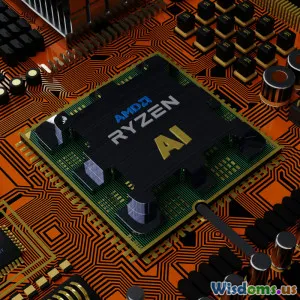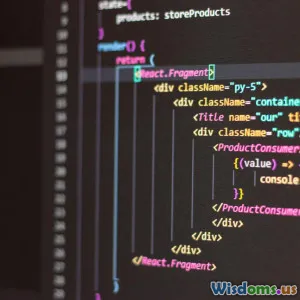
How Rust Is Disrupting Systems Programming and What To Expect Next
10 min read Explore how Rust is revolutionizing systems programming with safety and performance, and what future advancements await this transformative language. (0 Reviews)
How Rust Is Disrupting Systems Programming and What To Expect Next
Introduction
In the fiercely competitive and critical world of systems programming, picking the right language can mean the difference between stability and catastrophic failure. For decades, languages like C and C++ have dominated this landscape, balancing control and efficiency — but often at a high cost in safety and complexity. Enter Rust: a programming language quietly engineered to disrupt this status quo. Promising memory safety, concurrency freedom, and blazing performance, Rust is no longer just the language of tomorrow — it's reshaping how systems are built today.
This article dives deeply into how Rust is revolutionizing systems programming, supported by concrete examples, industry insights, and what the future may hold for this rapidly growing ecosystem.
The Traditional Systems Programming Landscape: Challenges and Limitations
Systems programming is the backbone of software that runs close to the hardware — operating systems, embedded software, device drivers, and high-performance network applications. Historically, this has been dominated by C and C++ for several reasons:
- Fine-grained Control: Low-level memory manipulation allows close-to-the-metal optimization.
- Wide Ecosystem: Mature tools, large codebases, and extensive libraries.
However, these advantages come with costly trade-offs:
- Memory Safety Issues: The prevalence of bugs like buffer overflows, dangling pointers, and data races leads to vulnerabilities and crashes.
- Manual Resource Management: Developers bear heavy burdens managing memory and concurrency explicitly.
- Complex Debugging: Unsafe behaviors are hard to detect early, causing prolonged development and maintenance cycles.
These challenges have caused many high-profile security vulnerabilities and catastrophic bugs in software infrastructure. For example, the infamous Heartbleed bug in OpenSSL was a classic memory safety flaw that exploited C's inherent unsafety.
Enter Rust: Redefining Systems Programming with Safety and Performance
Rust emerged from Mozilla Research in 2010 as an open-source project with a bold ambition: to create a language offering systems-level performance without sacrificing memory safety. Its key innovations include:
1. Ownership and Borrowing — Preventing Memory Errors at Compile Time
Rust’s ownership model enforces strict rules about who owns and can mutate data. References can be either mutable or immutable, but never both at once, preventing data races at compile time. This is enforced through Rust’s unique borrow checker.
Take this snippet as an example:
fn main() {
let mut s = String::from("hello");
let r1 = &s; // immutable borrow
let r2 = &s; // another immutable borrow
let r3 = &mut s; // mutable borrow - ERROR
}
The compiler will reject this because simultaneous mutable and immutable references could lead to undefined behavior. This design ensures safety without runtime costs, which is a revelation for traditional systems programmers.
2. Zero-Cost Abstractions
Rust promises abstractions that compile down to the same machine code as hand-written C code. This principle enables high-level features like pattern matching, generics, and concurrency primitives without sacrificing performance.
For instance, Rust's async runtime enables writing concurrent network servers that rival or exceed C++ in efficiency, but with easier-to-read code and built-in safety.
3. Built-In Concurrency Support
Rust treats concurrency as a core design goal. By preventing data races at compile time, it enables fearless concurrency �9— developers can write parallel code without the typical pitfalls.
Real-world projects like Dropbox's file synchronization engine and Cloudflare's edge computing services harness Rust's features to build faster, safer components at scale.
4. Rich Tooling and Package Ecosystem
Cargo, Rust's package manager and build system, has become a beloved tool in the developer community. It simplifies dependency management, builds, testing, and publishing — critical factors in reducing development friction.
Furthermore, crates.io hosts thousands of libraries fit for systems programming demand — from embedded device drivers to high-performance cryptographic routines.
Real-World Impact: Where Rust Is Making Waves
Rust's practical benefits extend widely across industries. Here are illustrative examples emphasizing its disruptive influence:
Mozilla’s Servo Browser Engine
Rust’s birth accompanies Mozilla’s initiative to develop Servo, an experimental browser engine aiming to replace Gecko. Servo showcases how Rust allows intricate parallel processing of web pages safely. Though still experimental, Servo proves Rust's potential for complex systems projects beyond traditional networking code.
Microsoft’s Adoption for Secure Systems
Microsoft has publicly shared efforts to leverage Rust within Windows components to reduce vulnerabilities tied to unsafe memory management. In 2021, Microsoft announced internal projects translating key Windows drivers and security-critical modules into Rust.
Amazon Web Services and Cloudflare
AWS incorporated Rust into its infrastructure, including Lambda functions and open-source tools. Cloudflare employs Rust in edge servers to optimize performance and enhance security viral bottlenecks. These endorsements validate Rust’s growing foothold in enterprise-grade systems.
Embedded Systems and IoT
Rust’s promise is compelling in low-resource IoT devices, where safety, concurrency, and power efficiency matter. Projects like Tock OS demonstrate using Rust for secure embedded operating systems, safeguarding connected devices from hacking risks.
What Lies Ahead: The Future of Rust in Systems Programming
Rust’s trajectory suggests a profound reshaping of systems programming conventions. Here's what to expect next:
1. Increasing Industry Adoption and Community Growth
Rust’s consistently rising downloads and star growth on GitHub, coupled with corporate backing, forecast deeper integration into commercial and open-source systems projects.
2. Enhanced Compiler and Language Features
Ongoing development focuses on:
- Async Improvements: Streamlining asynchronous programming for smoother UX.
- Const Generics: More powerful compile-time code to reduce runtime expense.
- Improved IDE Integration: Boosting developer productivity with smarter tooling.
3. Better Interoperability with Existing Codebases
The practical reality for many organizations is migrating massive C/C++ codebases incrementally. Rust is advancing interop bindings and FFI (Foreign Function Interface) mechanisms to ease this integration, rather than demanding full rewrites upfront.
4. Education and Skill Accessibility
The industry will see more Rust-focused training and university curricula to reduce entry barriers. As more systems engineers gain Rust fluency, expect broader ecosystems and knowledge sharing.
5. New Domains and Paradigms
Some emerging directions include:
- WebAssembly (Wasm): Rust compiles excellently to Wasm, making it ideal for secure, high-performance browser applications.
- Blockchain and Cryptography: Safety and correctness are paramount in these fields, with Rust gaining enthusiastic adoption.
Challenges and Considerations
While promising, Rust adoption requires grappling with challenges:
- Steep Learning Curve: The ownership model is powerful but non-intuitive initially.
- Ecosystem Maturity: While growing fast, some specialized libraries and tooling lag behind C++ equivalents.
- Compile Times: Rust’s compile times can be longer, impacting development speed.
Organizations must weigh these factors and apply Rust strategically where it offers clear value.
Conclusion
Rust is far more than a new syntax or paradigm twist; it's a transformative force in systems programming. By solving perennial problems of memory safety, concurrency, and performance without compromise, Rust empowers developers to build the future infrastructure in ways previously thought impossible.
Its adoption by tech giants, community vitality, and advancing language features foresee an exciting era where software components are faster, safer, and more maintainable.
For systems engineers, embracing Rust today is not just about learning a new language — it’s about rethinking software craftsmanship in a digital world demanding both speed and security.
Whether you lead embedded development, cloud infrastructure, or security-critical applications, Rust invites you to reimagine what's achievable and prepare for a systems programming future rewritten in its safe, efficient code.
Rate the Post
User Reviews
Popular Posts



















